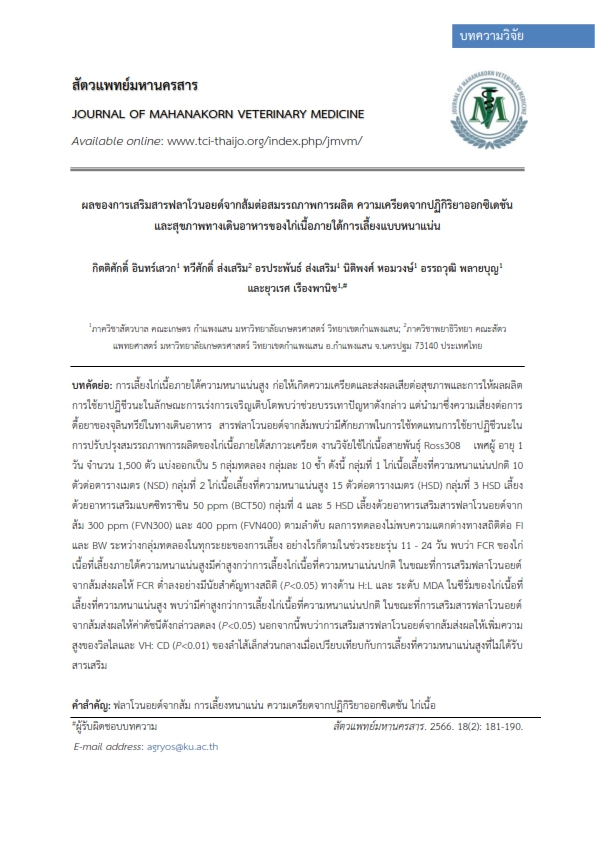Effect of Citrus Flavonoids Supplementation on Growth Performance, Oxidative Stress, and Gut Health of Broilers Raised under High Stocking Density
Main Article Content
Abstract
High stocking density can cause stress which leads to negative effects on broiler health and growth performance. Although antibiotic growth promoters (AGPs) could be used to alleviate these effects, they could raise the risk of antibiotic-resistant pathogens. This citrus flavonoid is a potential as an alternative to AGPs. A total of 1,500 one-day-old male chicks (Ross308) were divided into 5 treatments with 10 replicates including, 1) normal stocking density (NSD, 10 birds/m2), 2) high stocking density (HSD, 15 birds/m2), 3) HSD with 50 ppm Bacitracin (BCT50), 4) HSD with 300 ppm citrus flavonoids (FVN300), and 5) HSD with 400 ppm citrus flavonoids (FVN400). There was no significant different in FI and BW (P >0.05) among dietary treatments in all period of experiment. However, during 11-24 DOA, FCR of HSD was significantly higher than the NSD (P<0.05). The supplementation FVN at both levels showed the positive effect on lowering FCR of NSD birds (P<0.05). At 35 DOA, the level H:L ratio and serum MDA levels of HSD birds were significantly higher than those of NSD birds (P<0.05) were significantly decreased in the supplementation FVN at both levels significantly lower these parameters when compared to that of the HSD (P<0.05). The supplementation of FVN significantly increased jejunal villus height and VH: CD ratio of HSD birds (P<0.01). FVN showed a very promising improvement of oxidative stress status and gut health of broilers.
Article Details

This work is licensed under a Creative Commons Attribution-NonCommercial-NoDerivatives 4.0 International License.
References
Abudabos, A.M., Samara, E.M., Hussein, E.O.S., Al-Ghadi, M.Q. and AlAtiyat, R. M. 2013. Impacts of stocking density on the performance and welfare of broiler chickens. Ital. J. Anim. Sci. 12: e66–e71.
Brunnsgaard, G. 1998. Effects of cereal type and feed particle size on morphological characteristics epithelial cell proliferation and lectin binding patterns in the large intestine of pig. J. Anim. 76: 2786-2798.
Guardia S. 2011. Effects of stocking density on the growth performance and digestive microbiota of broiler chickens. Poult. Sci. 90: 1878-1889.
Gomes, A.V.S., Quinteiro-Filho, W.M., Ribeiro, A., Ferraz-de-Paula, V., Pinheiro, M.L., Baskeville, E., Akamine, A.T., Astolfi-Ferreira, C.S., Ferreira, A.J.P., Palermo-Neto, J. 2014. Overcrowding stress decreases macrophage activity and increases Salmonella enteritidis invasion in broiler chickens. Avian. Pathol. 43: 82–90.
Grotto, D., Santa Maria, L.D., Boeira, S., Valentini, J., Charão, M.F., Moro, A.M., Nascimento, P.C., Pomblum, V.J. and Garcia, S.C. 2007. Rapid quantification of malondialdehyde in plasma by high performance liquid chromatography-visible detection. J. Pharm. Biomed. Anal. 43: 619–624.
Kabploy, K., Bunyapraphatsara, N., Morales, N.P. and Paraksa, N. 2016. Effect of antibiotic growth promoters on anti-oxidative and anti-inflammatory activities in broiler chickens. Thai. J. Vet. Med. 46(1): 89-95.
Kamboh, A.A., Hang, S.Q., Bakhetgul, M. and Zhu, W-Y. 2013. Effects of genistein and hesperidin on biomarkers of heat stress in broilers under persistent summer stress. Poult. Sci. 92: 2411-2418.
Kim, H.P., Kun, H.S., Hyeun, W.C. and Sam, S.K. 2004. Anti-inflammatory plant flavonoids and cellular action mechanisms. J. Pharmacol. Sci. 96: 229-245.
Li, W., Wei, F., Xu, B., Sun, Q., Deng, W., Ma, H., Bai, J. and Li, S. 2019. Effect of stocking density and alpha-lipoic acid on the growth performance, physiological and oxidative stress and immune response of broilers. Asian Austral. J. Anim. 32(12): 1914-1922.
Niewold, T.A. 2007. The nonantibiotic anti-inflammatory effect of antimicrobial growth promoters, the real mode of action? A hypothesis. Poult. Sci. 86: 605–609.
Nimse, S.B. and Pal, D. 2015. Free radicals, natural antioxidants, and their reaction mechanisms. RSC Adv. 5(35): 27986-8006.
Panche, A.N, Diwan, A.D. and Chandra, S.R. 2016. Flavonoids: an overview. J. of Nutri. Sci. 5(47): 1-15.
Prevatto, J.P., Torres, R.C., Diaz, B.L., Silva, P.M.R., Martins, M.A., and Carvalho, V.F. 2017. Antioxidant Treatment Induces Hyperactivation of the HPA Axis by Upregulating ACTH Receptor in the Adrenal and Downregulating Glucocorticoid Receptors in the Pituitary. Oxid. Med. Cell Longev. 2017: 4156361.
Turan, A. and Mahmood, A. 2007. The profile of antioxidant systems and lipid peroxidation across the crypt-villus axis in rat intestine. Dig. Dis. Sci. 52: 1840-1844.
Zhou, Y., Mao, S. and Zhou, M. 2019. Effect of the flavonoid baicalein as a feed additive on the growth performance, immunity, and antioxidant capacity of broiler chickens. Poult. Sci. 98 (7): 2790-2799.
Zhu, A.N., Zhang, K.Y., Wang, J.P., Bai, S.P., Zeng, Q.F., Peng, H.W. and Ding, X.M. 2021. Effect of different concentrations of neohesperidin dihydrochalcone on performance, egg quality, serum biochemistry and intestinal morphology in laying hens. Poult. Sci. 100: 101387.


